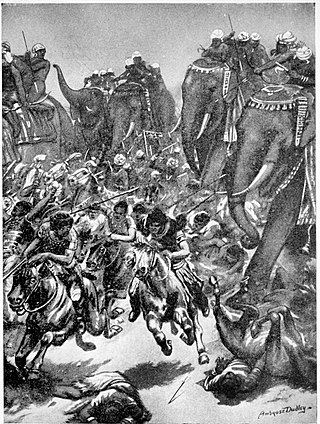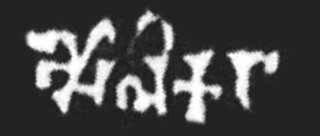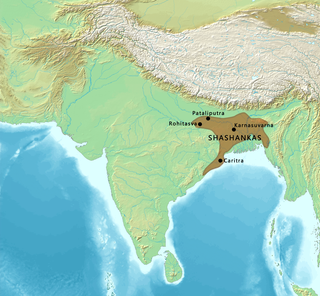Related Research Articles
The Gupta Empire was an ancient Indian empire on the Indian subcontinent which existed from the mid 3rd century CE to mid 6th century CE. It was the seventh ruling dynasty of Magadha. At its zenith, from approximately 319 to 467 CE, it covered much of the Indian subcontinent. This period has been considered as the Golden Age of India by historians, although this characterisation has been disputed by some other historians. The ruling dynasty of the empire was founded by Gupta and the most notable rulers of the dynasty were Chandragupta I, Samudragupta, Chandragupta II, Kumaragupta I and Skandagupta.

Chandragupta I was a monarch of the Gupta Empire, who ruled in northern and central India. His title Mahārājadhirāja suggests that he was the first suzerain ruler of the dynasty. It is not certain how he turned his small ancestral kingdom into an empire, although a widely accepted theory among modern historians is that his marriage to the Licchavi princess Kumaradevi helped him extend his political power. Their son Samudragupta further expanded the Gupta empire.

Mandsaur is a city and a municipality in Mandsaur district located on the border of Mewar and Malwa regions of Madhya Pradesh, a state in Central India. It is the administrative headquarters of Mandsaur District. The ancient Pashupatinath Temple is located in Mandsaur. Later come under Gwalior state Which was 2nd biggest state. Mandsaur is famous for its opium farming.

The Kanva dynasty or Kanvavamsha was the sixth ruling dynasty of Magadha, established after Vasudeva Kanva overthrew the preceding Shunga dynasty and ruled from 73 BCE to 28 BCE.

Kosala, sometimes referred to as Uttara Kosala was one of the Mahajanapadas of ancient India. It emerged as a small state during the Late Vedic period and became one of the earliest states to transition from a lineage-based society to a monarchy. By the 6th century BCE, it had consolidated into one of the four great powers of ancient northern India, along with Magadha, Vatsa, and Avanti.

Yashodharman was the ruler of the Malava Empire in North India, from 515 until his death in 545. He belonged to the Second Aulikara dynasty. He conquered much of the Indian subcontinent between c. 530–540 according to the Mandsaur pillar inscription.
Shashanka was the first independent king of a unified polity in the Bengal region, called the Gauda Kingdom. He reigned in the 7th century, some historians place his rule between c. 600 and 636/7 CE, whereas other sources place his reign between 590 and 625 CE.

The History of Bihar is one of the most varied in India. Bihar consists of three distinct regions, each has its own distinct history and culture. They are Magadha, Mithila and Bhojpur.Chirand, on the northern bank of the Ganga River, in Saran district, has an archaeological record dating from the Neolithic age. Regions of Bihar—such as Magadha, Mithila and Anga—are mentioned in religious texts and epics of ancient India. Mithila is believed to be the centre of Indian power in the Later Vedic period. Mithila first gained prominence after the establishment of the ancient Videha Kingdom. The kings of the Videha were called Janakas. A daughter of one of the Janaks of Mithila, Sita, is mentioned as consort of Lord Rama in the Hindu epic Ramayana. The kingdom later became incorporated into the Vajjika League which had its capital in the city of Vaishali, which is also in Mithila.

Avanti, was an ancient Indian Mahajanapada, roughly corresponding to the present-day Malwa region. According to the Buddhist texts, the Anguttara Nikaya, Avanti was one of the solasa mahajanapadas of the 6th century BCE. The janapada was divided into two parts by the Vindhyas, the northern part had its capital at Ujjayini and the southern part had its centre at Mahishmati.

Pradyota dynasty, also called Prthivim Bhoksyanti, was a ruling dynasty of Avanti, founded by Pradyota, after his father Punika, a minister in the court of the king of Ujjaini, the northern part of the former Avanti kingdom, and placed his own son on the throne in 546 BCE.
There are conflicting theories regarding the original homeland and ancestry of the Gupta dynasty that ruled northern India between 4th and 6th centuries. Modern historians variously theorize that it originated in present-day Uttar Pradesh or Bengal, based on epigraphic, numismatic and literary evidence. The social group (varna) of the dynasty is also a matter of debate, with scholars variously placing them in Vaishya, Brahmana, or other categories.

The Aulikaras, were an ancient clan that ruled the Kingdom of Daśapura between the 4th-century CE and 6th-century CE.
Jettha Tissa I also referred to as Detu Tiss, Kalakandetu Tissa, and Makalan Detu Tissa, was the eldest son of Gothabhaya and brother of Mahasena. He was a king of Sri Lanka for ten years.

The Gauḍa kingdom was a kingdom during the Classical era in the Indian subcontinent, which originated in the Gauda region of Bengal in 4th century CE or possibly earlier.
Prabhakaravardhana was a king of Thanesar in northern India around the time of the decline of the Gupta Empire. According to the historian R. C. Majumdar, he was the first notable king of the Vardhana dynasty but the fourth ruler from the family, who are also referred to as the Pushpabhutis. He had been preceded by his father, Adityavardhana, grandfather Rajyavardhana I and great-grandfather, Naravardhana, but inscriptions suggest that Banabhatta, the seventh-century bard and chronicler of the Vardhanas, may have been wrong to call these earlier rulers kings and that they may instead have been mere feudatory rulers of minor significance.

The Later Gupta dynasty, also known as the Later Guptas of Magadha, were the rulers of Magadha and Malwa from the 6th to 8th centuries CE. The Later Guptas emerged after the disintegration of the Imperial Guptas as the rulers of Magadha and Malwa however, there is no evidence to connect the two dynasties and the Later Guptas may have adopted the -gupta suffix to link themselves the Imperial Guptas.
Govindagupta was a Gupta prince of ancient India. He was a son of Chandragupta II and Dhruvadevi, and a brother of Kumaragupta.
The Second Aulikara dynasty was a royal dynasty that ruled over the Kingdom of Daśapura, and at its peak under Yashodharman Vishnuvardhana controlled a vast area, consisting of almost all of Northern India and parts of Deccan plateau. It was the second royal house of the Aulikara clan.

The Battle of Sondani was a large military encounter fought in 528 CE, between the Alchon Hun king Mihirakula and a confederation of Indian rulers led by King Yashodharman of Malwa and King Narasimhagupta of the Gupta Empire.
Mahasenagupta was King of Magadha from 562 until his defeat in 575 and thereafter the King of Malwa until his death in 601. He belonged to the Later Gupta dynasty of Magadha.